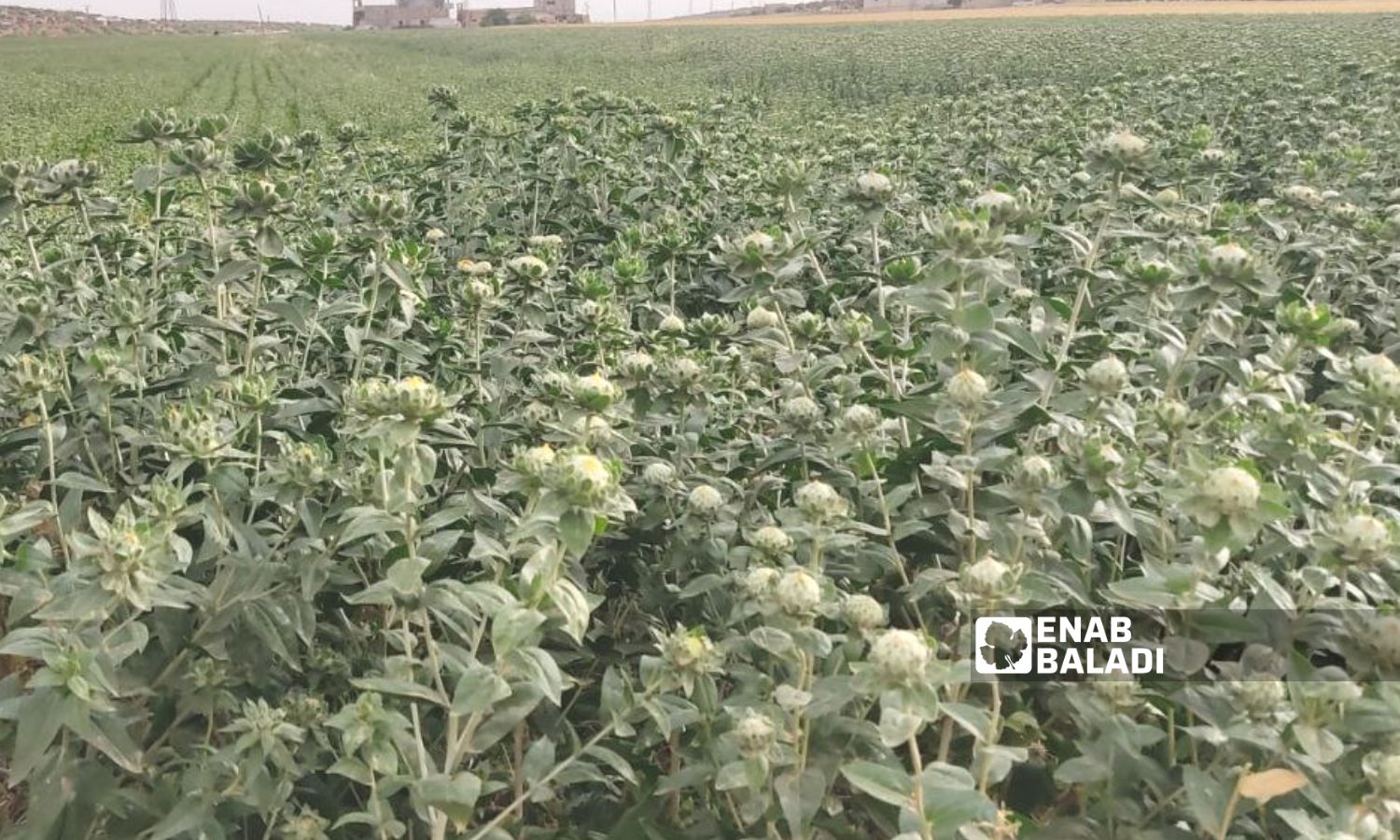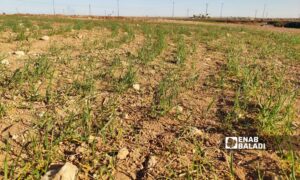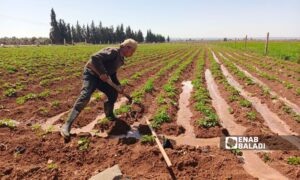
Yields tempt farmers; Safflower cultivation expands in Idlib

Idlib countryside – Iyad Abdul Jawad
The areas of land cultivated with safflower have increased in the northwestern Idlib governorate during 2023 compared to previous years.
Safflower is one of the winter/spring-growing annual herbs that farmers from the northern and western countryside of Hama and the southern countryside of Idlib moved to the area after they were displaced and settled there.
Farmer Ibrahim Rahal, 60, an IDP from Maarat Harmah in the southern countryside of Idlib, told Enab Baladi that safflower cultivation was previously widespread in the city of Maarat al-Numan and its countryside and the southern countryside of Idlib. It is about harvesting the florets that come out of the rose after its maturity and using it as a kind of food spice.
Rahal said that farmers benefit from florets and seeds, as safflower oil is extracted from them, and part of the seeds are used as fodder for birds and animals, and some of it is exported to neighboring countries, where a ton of it is sold for about $600.
During the year 2022, farmers sold a kilo of safflower for about $17. However, the farmers’ interest in cultivating it this year could negatively affect the selling price, according to the farmer.
Expensive cultivation but good with yield
Khaled Mustafa, 50, from the town of Killi, told Enab Baladi that the framers of the area used to grow wheat, lentils, chickpeas, black cumin, and cumin, pointing out that the cultivation of safflower is one of the somewhat modern crops in the region, as a result of the displacement of hundreds of farmers.
During the current year, the area of land cultivated with safflower has increased, according to Mustafa, citing the reasons for this because it is profitable cultivation, and although it is expensive and difficult to harvest, the safflower plant resists all weather factors.
This year, Khaled Mustafa planted ten dunams of safflower, pointing out that the most important difficulty facing farmers is securing the labor force.
The safflower harvest takes place at a specific time and requires experience, as the harvest begins at the end of May, and it takes 20 days for the flowers to bloom, and in several stages, then the stage of exposing the harvest to the sun’s rays until the stage of dryness.
Safflower cultivation is somewhat expensive for farmers, as every four kilograms of florets equals only one kilogram when dried and prepared for sale, according to farmer Rahal.
The farmer indicates that the cultivation of the crop must begin in December, and during the five months between planting and harvesting, the crop needs to remove weeds that may surround it more than once during this period.
Safflower cultivation requires seedlings, seeds, irrigation, and fertilizers of different types, which increases the cost of its production for farmers.
120 tons of florets in 2023
The director of the General Directorate of Agriculture in the Syrian Salvation Government (SSG) operating in Idlib, Tamam al-Hamoud, told Enab Baladi that the areas planted with safflower this year amounted to about 802 hectares, indicating that the expected production volume is about 1,000 tons of seeds and 120 tons of florets.
Al-Hamoud pointed out that the cultivation of safflower in Idlib did not affect other crops. Rather, it was a substitute for some medicinal and aromatic crops, especially Nigella sativa, whose prices in 2022 were the lowest in the world. It was also affected by diseases, as it is sensitive to many fungal diseases and pests.
The local official emphasized the increase of its agricultural areas in the region, given that it is economically feasible for farmers, its water needs are limited, and it is disease-resistant.
It is expected that one hectare of land planted with safflower will produce about 1,000 to 1,500 kilograms of seeds, and approximately 100 to 150 kilograms of flowers or florets, according to al-Hamoud.
Two seasons a year
Safflower is a semi-spinous perennial plant belonging to the Compositae family. It grows in a warm climate, and its cultivation is used to secure oil, which is considered one of the oils for human consumption.
The percentage of oil in its seeds ranges between 25 and 40%, depending on the variety and planting date, and it is one of the healthy oils because of the high percentage of unsaturated oils, especially linoleic and oleic acids.
Ghassan Abboud, the agricultural engineer, told Enab Baladi that safflower can be grown in various fertile and medium-fertile lands. It is grown in areas with an average rainfall of 350 mm or more. It is also grown irrigated, as it needs 3-5 waterings until maturity.
Abboud added that safflower in Syria is grown in two seasons, the first winter season starts from mid-November until the end of December, and the second spring season starts from mid-March until the end of April, and in this ripening period, the safflower plant needs irrigation according to the need and the rate of rain.
The plant is usually grown in limited areas on marginal lands or as an intercropping between olive trees, in which the planting distances between trees are large, and newly reclaimed lands, according to the engineer.
Abboud considers that the crop has entered the agricultural cycle in some places in northern Syria and has contributed to improving soil properties and increasing the number of beekeepers since the flowering season is long and contributes to bee food for a significant period.
if you think the article contain wrong information or you have additional details Send Correction
النسخة العربية من المقال
-
Follow us :

















 A
A
A
A
A
A








 More Economic Reports
More Economic Reports